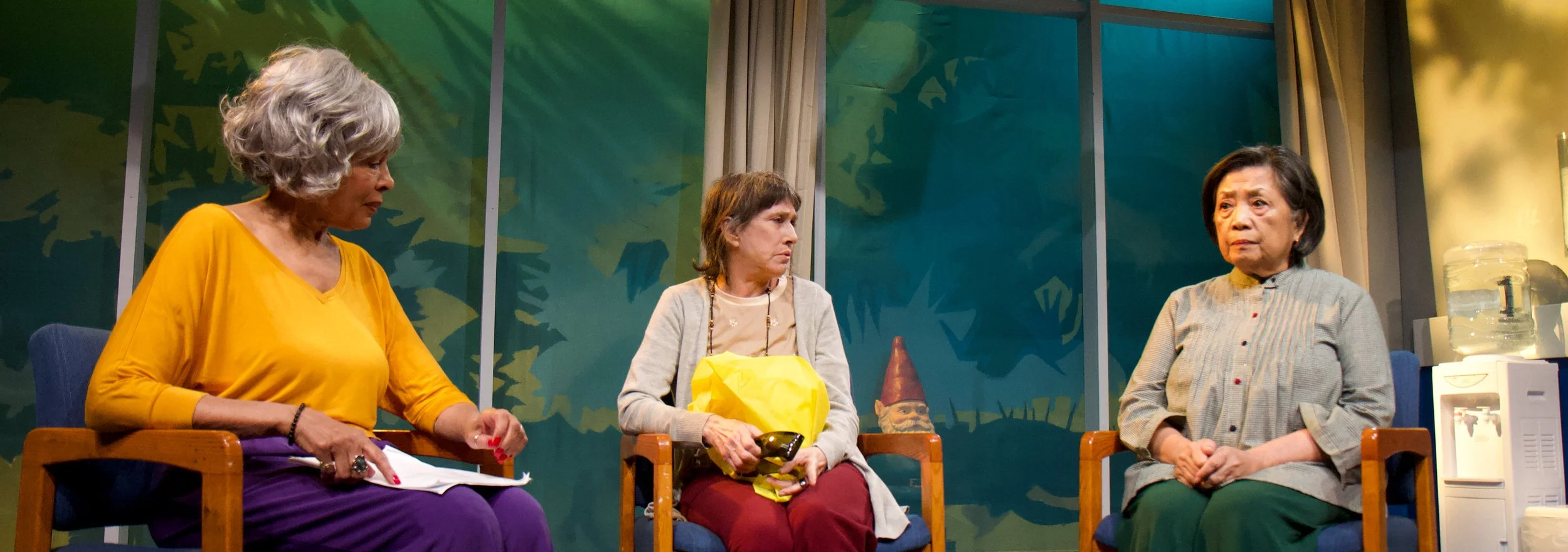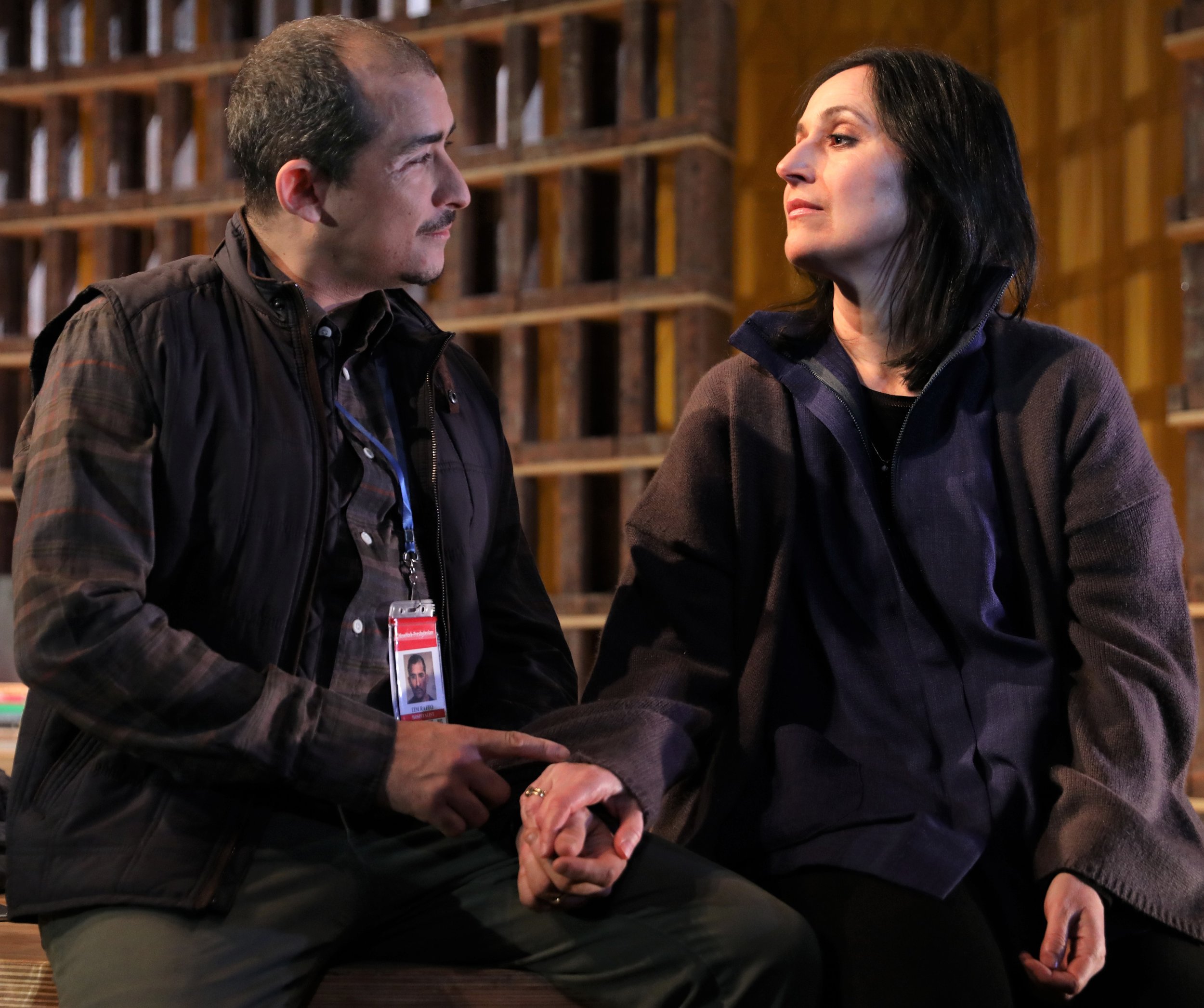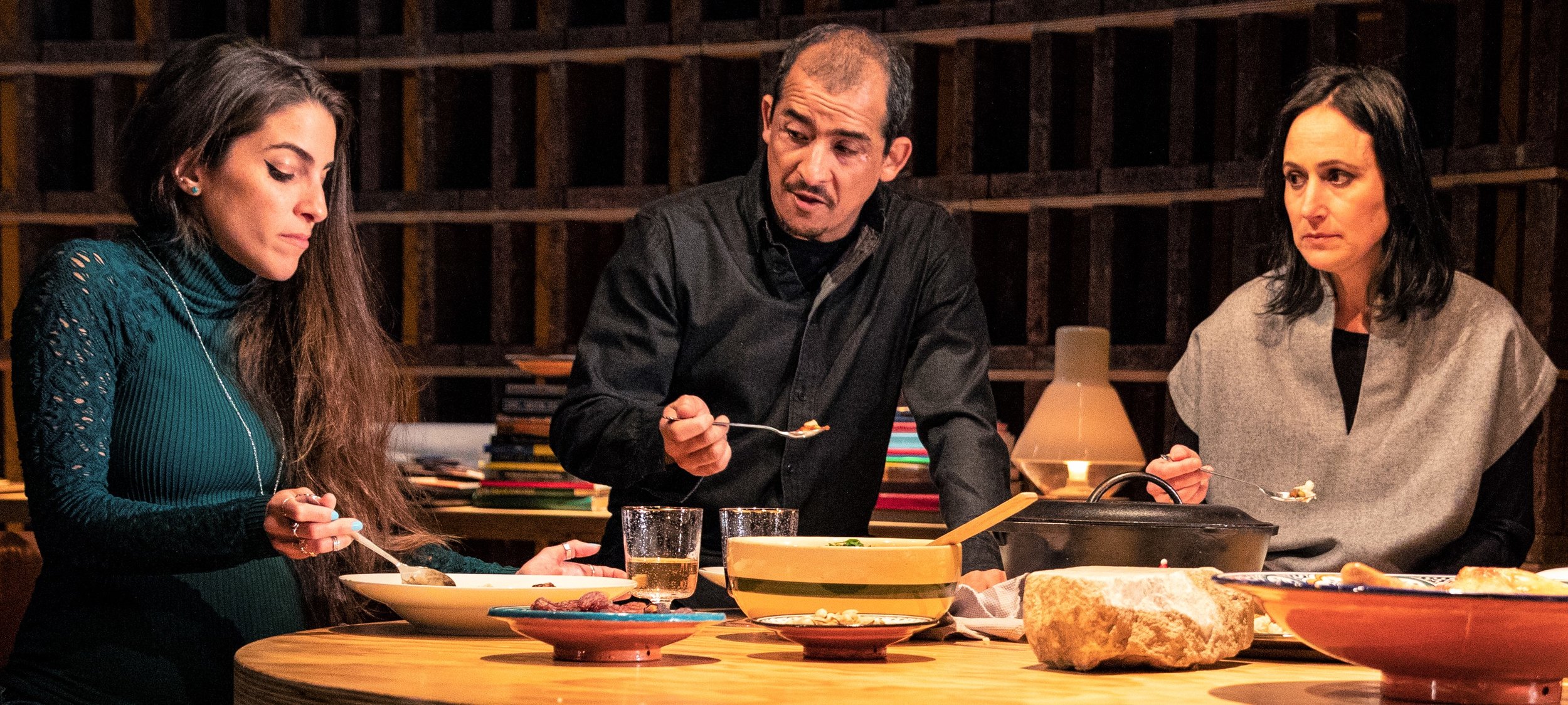Ryan J. Haddad’s Hold Me in the Water, like the dramatist himself, is charming and effervescent. Also like Haddad, it’s slender (though that word has different connotations when applied to the human form and to an Off-Broadway play).
The Antiquities
Stories on stage and screen that engage with, critique, or warn about artificial intelligence (AI) are as much in vogue as AI itself. McNeal, about art and AI, recently concluded its Broadway run; We Are Your Robots and Prometheus Firebringer at Theater for a New Audience addressed collective veneration of the technology Off-Broadway; and Companion, a twisted and funny exploration of human and nonhuman desire, opened this month in movie theaters. Now, Jordan Harrison’s The Antiquities, an episodic look at our current technological moment—or precipice—through the artificial eyes of the future, enters the AI discourse at Playwrights Horizons (co-produced with the Vineyard Theatre and the Goodman Theatre).
Staff Meal
An underlying anxiety is on display in Abe Koogler’s Staff Meal about the appeal of his absurdist play: exhibit A is a character listed as Audience Member in the program (Stephanie Berry), who interrupts the proceedings about 30 minutes into the show to offer a detailed explanation of why she is not pleased:
Is this a play about restaurants or the people who work there? I’d happily watch a play about that—if it was different.
Take a stand! Inspire action! Touch our hearts—or at least you should try!
We’ve given this gift to you of our evening—one of our precious few nights on this earth—and you’re showing us this?????
Teeth
Michael R. Jackson and Anna K. Jacobs’s new musical Teeth has bite. Adapted from Mitchell Lichtenstein’s 2007 cult horror-comedy film of the same name and directed by Sarah Benson, Teeth is a tongue-in-cheek look at sex, shame, religious repression, and more. The story revolves around a devout evangelical teen named Dawn who discovers she has a secret weapon: vagina dentata (Latin for “toothed vagina”), which swings into action when she is sexually threatened.
Stereophonic
A huge audio console occupies center stage in the Playwrights Horizons’ unhurried and precisely observed world premiere of Stereophonic. This makes sense not only because all of the action is set within the close confines of a music studio, but also because it is an apt metaphor for what playwright David Adjmi and songwriter Will Butler have in mind. Their musical drama chronicles a year in the life of a rock band and its tech team as they go about recording a new album. Decibel levels rise and fall as tensions mount, then subside, while the chance for harmony among the bandmates is continually thwarted by their insecurities, jealousies and self-indulgences. It’s a volatile mix.
Wet Brain
Memory, when conveyed on stage, traditionally arrives in the form of a flashback, or a soliloquy. But in John J. Caswell, Jr.’s frantic and surreal family drama Wet Brain, memory is a foreign object to be cut from the stomach, or a hypersonic shared experience that blasts through outer space even as it is grounded in that most triggering of locales, the family room in the house of a decidedly dysfunctional brood.
The Trees
Agnes Borinsky’s The Trees is a quirky and ambitious new play that may please some environmentalists and Thoreau-minded folk, but many theatergoers may find it hard to warm up to this work, populated with a dozen characters, many of whom flit in and out of the play in will-o’-the-wisp fashion. Directed by Tina Satter, The Trees investigates the American dream and questions whether stability is possible in a capitalistic world.
Catch as Catch Can
Riding a risky wave of experimental casting, three Asian-American actors defy gender, age, ethnicity and a law or two of physics in Mia Chung’s comedy-drama, Catch as Catch Can. Without the aid of costume change, and only occasional differences in lighting, the three performers inhabit six closely linked characters, gliding in and out of each.
Tambo & Bones
When the lights came up at the end of Dave Harris’s disorienting Tambo & Bones, my companion asked me, “Am I real?” The satirical play teasingly calls attention to the artifice of theater and performance while emphasizing “fake-ass” set pieces, “fake-ass” backstories, and “fake-ass” racial identities. Even the composition of the audience at Playwrights Horizons seems to be fabricated. I wasn’t so sure I could give my friend an answer.
Selling Kabul
Selling Kabul, Sylvia Khoury’s play currently running at Playwrights Horizons, is significant and timely. Although written in 2015, the drama’s focus on the collateral damage of the pullout of U.S. forces in Afghanistan is even more urgent in light of President Biden’s complete withdrawal three months ago. Significant, timely, and urgent do not, however, necessarily make for great theater. To its credit, Selling Kabul does not minimize the political and ideological concerns, but it offers an impressively riveting, suspenseful, and deeply moving portrayal of four complex individuals caught up in the sweep of national turmoil.
The Thin Place
Lucas Hnath, recently represented on Broadway by the spun-from-fact Hillary and Clinton, and soon to be represented at the Vineyard by Dana H., a story drawn from family experience, is cleansing his theatrical palate between them with The Thin Place, a story of the afterlife that conjures up the eerie worlds of Conor McPherson and M.R. James. The dedication to Ricky Jay, the late magician, indicates Hnath is out to perform his own sleight of hand with a deeply unsettling ghost story.
Heroes of the Fourth Turning
Playwrights Horizons is currently housing an unexpected thing in New York City: conservatives openly discussing their beliefs. And liberal New Yorkers are, and should be, flocking to it. Providing a respite from the shock-jock conservatism of Donald Trump and Fox News, Will Arbery’s new play Heroes of the Fourth Turning puts Catholic conservatism onstage in all of its messiness and nuance, daring its audience to listen to what the other side has to say—and maybe even making them care about the characters doing the talking.
Wives
Jaclyn Backhaus’s Wives, at Playwrights Horizons under the direction of Margot Bordelon, is a raucous, funny, well-acted, and well-intentioned production that suffers from intermittent heavy-handedness and whose four distinct parts don’t fully cohere. The final of the four vignettes that comprise the 80-minute play tries to wrangle the previous three stories, which originated as ideas for three separate plays, into a harmonious symmetry, but it only muddies the waters so that Wives ends up feeling like partially thought-out ideas awaiting fuller exploration.
The Pain of My Belligerence
The first scene of Halley Feiffer’s new drama is a bear trap. It seizes one’s attention and won’t let go. Feiffer, who stars as Cat, is having drinks and hors d’oeuvres with Guy, a restaurateur whose wife she has profiled for The New Yorker. He’s explaining to her his design of the Japanese restaurant they are in; as performed by Hamish Linklater, he is arrogant, charming, playful, insulting, and possibly dangerous.
Noura
Heather Raffo’s Noura scrutinizes the issue of assimilation of refugees into American society by looking at the experience of the title character, an Iraqi woman. Noura (played by Raffo herself) is a stern but loving mother and wife who escaped the ISIS capture of Mosul with her husband, Tareq (Nabil Elouahabi). After setting down roots in the new country, Noura finds that she desperately misses her hometown traditions. Raffo’s play echoes a question that Arthur Miller, in his essay The Family in the Modern Drama, asks: “How may a man make of an outside world a home?” For Raffo, the question is: “What keeps a family together?” The play reveals ways that American life can create isolation more than togetherness.
Liam Campora (left) plays Yazen, or Alex, and Matthew David is Rafa’a, a family friend, in Heather Raffo’s Noura. Top: Raffo as Noura, with Nabil Elouahabi as her husband, Tareq.
Noura, one of the Christian minority in Mosul, holds on to the Christmas traditions she was raised with as the only things left from the rubble of her hometown. She remembers the way her old neighbors would visit her father’s house on Christmas for a jubilee of dancing, good food and conversation. But in America the fast-paced and alienating effects of social media and personal technologies, such as cell phones and gaming systems, have made it harder for her family to hold on to those traditions.
Her son, whom she calls Yazen but who is also known by an Americanized name, Alex (Liam Campora), is just interested in his PlayStation and hates the fast his family observes. He begs to live a normal American life. Tareq, meanwhile, has come to terms with his new life. He is no longer able to be a surgeon as he once was in Mosul; he now works at a sandwich shop and takes up shifts that cut into his spending time with the family. Noura is thinking of continuing her career as an architect and struggles with how small and uncommunal her family has become. Noura, directed by Joanna Settle, shows that retaining one’s true identity in a new country is a struggle filled with compromises.
There’s also the family’s close friend, Rafa’a (Matthew David) and Maryam (Dahlia Azama), an orphan from Mosul who is sponsored by Noura and Tareq. Rafa’a serves as an interesting sounding board to Noura’s concerns about the life in Mosul, as well as Tareq’s sacrificing of his career and whether or not they have made the right choices in the years they have lived in America. Maryam, who comes for the holidays before going back to Stanford, carries a secret that causes Noura to question holding on to the traditions. She feels pressure to reveal the secrets she carried overseas to New York. The shorthand question in Raffo’s play is summed up by one that Rafa’a asks: Is holding on the old ways necessary?
Raffo and Elouahabi with Dahlia Azama (left) as Maryam. Photographs by Joan Marcus.
The set, designed by Andrew Lieberman, is grounded by a Christmas tree. Lighting designer Masha Tiriming’s lights gently swirl around the tree and glisten like stars in the darkness. It is a constant reminder of the holiday spirit: a time of togetherness and cheer, but it all looms over Noura’s family, who have splintered off from the traditions of her youth in Mosul. In the middle area is a tall structure that looks like a curved cage that encapsulates the family’s coming-together space; books, teapot, and other ornaments lie on the shelf attached to the structure. The table serves as a dinner table and a work station for Noura and is always cluttered. The floor and wall in Lieberman’s set are tiled with an Aramaic design that evokes the idea of the life that was left behind and the life that they are forced to embraced within their home.
But they also recognize the drawbacks of their old life. The communal life that Noura yearns for is mostly out of the sadness of the past she has left behind. Mosul also has a rugged individualism where there are Christian communities and Muslim communities that have strict rules of when mingling amongst each other. Middle Eastern culture prides itself on “deeply interwoven social fabric of community,” Raffo states in the program, while American culture “prides itself on rugged individualism.”
The actors embody the conflicts with intensity, their characters all fighting to have their perspectives heard. “What’s wrong with feeling safe?” says Tareq. “I’m grateful that there is a place we can reinvent ourselves, a place we can forget.” Noura responds, “I don’t want to forget! I’m trying desperately to remember who the hell I am.” There aren’t any clear answers in how to live their lives as true Iraqi-Americans, and no one gains leverage over another’s opinion.
What Noura does successfully is explore the challenges of living free and happy as an immigrant in America from many angles, as the characters express the various ways identity and culture can fulfill one’s sense of being—but it also shows how malleable traditions may become in the need for survival.
Log Cabin
Arriving during gay pride month, Jordan Harrison’s new play explores currents of non-heterosexual identity in a nearly comprehensive way. Its characters cover the waterfront in terms of gender fluidity, with side trips to racial and class identity. Allen Moyer’s primary set is an apartment with ceiling-high bookcases and comfortable modern furniture. In spite of the elegance, however, Harrison’s characters might as well be living in the titular log cabin. They are sexual pioneers lost in a wilderness of fluctuating gender identity rather than ferocious animals and untamed nature.
This Flat Earth
Lindsey Ferrentino’s This Flat Earth joins other recent plays in tackling a hot-button issue: Admissions at Lincoln Center examined affirmative action, and Miss You Like Hell at the Public is entwined with the deportation of illegal aliens, or undocumented immigrants, depending on one’s political leaning. Ferrentino’s chosen subject is gun violence in schools.
Miles for Mary
Miles for Mary, the sly new play at Playwrights Horizons, has a lengthy writing credit: “Written by Marc Bovino, Joe Curnutte, Michael Dalto, Lila Neugebauer and Stephanie Wright Thompson in collaboration with Sarah Lunnie and the creative ensemble of Amy Staats & Stacey Yen.” That credit may be accurate, but it’s also a wink at the audience. Miles for Mary is a comedy about a committee at a high school, and, defying dire axioms about things done by committee, it’s a hoot.
Mankind
Robert O’Hara’s new play, Mankind, opens with a gay couple’s strained pillow talk, as one man, Jason (Bobby Moreno), advises his partner, Mark (Anson Mount), that he is pregnant—by Mark. From that simple start O’Hara spins a broad, futuristic satire of sexuality, feminism, religion, commerce and talk shows. It’s more than the playwright is able to manage smoothly, and much of it feels familiar, but it has its moments before it arrives at its circular ending, one reminiscent of Ben Hecht and Charles MacArthur’s Twentieth Century.
The Treasurer
“Regarding suicide I just don’t have sad emotions,” says Jacob, the occasional narrator of The Treasurer, Max Posner’s deeply felt, sharply observed play about dementia and care-giving. Jacob (a no-nonsense, resentful Peter Friedman) is the hard-as-nails son who, along with Allen and Jeremy, the more accommodating brothers, must take care of his widowed mother, Ida (Deanna Dunagin, who charts a painfully realistic physical and mental decline). By the play’s end, Jacob is as sad as can be.




























